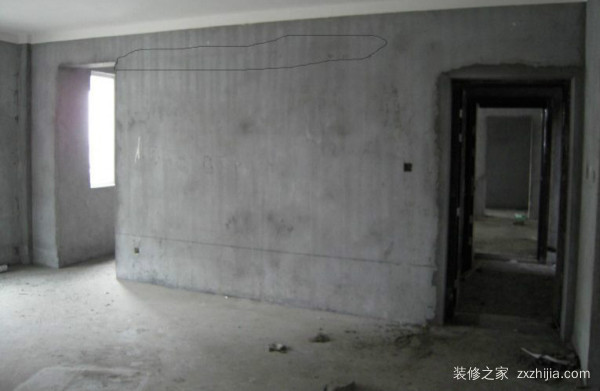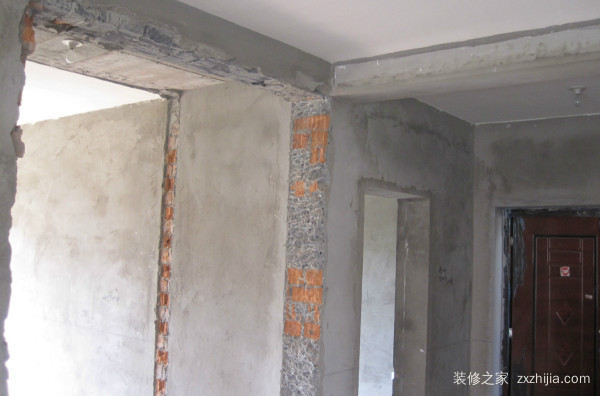The load-bearing wall is the wall that supports the weight of the entire floor. It plays a role in the safety protection of the whole building. The owners must pay attention to the protection of the load-bearing wall during the decoration process. Do not dismantle the load-bearing wall casually because it is related to The safety of the entire building. The private removal of the load-bearing wall will have a certain impact on the safety of the living environment and will also violate the law. So what is the load-bearing wall and the non-bearing wall ? Let's take a look at the identification method of the under load-bearing wall and the non-bearing wall.
What is a load bearing wall?
The load-bearing wall refers to the wall that supports the weight of the upper floor. On the engineering drawing, it is a black wall. If it is destroyed, it will destroy the entire building structure.
Generally speaking, all the walls of a brick-concrete structure are load-bearing walls; the walls inside the frame structure are generally not load-bearing walls. Of course, specific to the structure of the house itself, to determine whether the wall is a load-bearing wall, the original architectural drawings should be carefully studied and confirmed after actual site survey. The load-bearing wall is scientifically calculated. If the hole is repaired on the load-bearing wall, it will affect the stability of the foundation. requires attention.

What is a non-bearing wall?
A non-load bearing wall is a wall that plays a secondary role in a building. It only serves to separate one room from another, and it is a hollow wall on the drawing. Whether or not this wall has no major influence on the building structure. In fact, the non-bearing wall is not unloaded, its meaning is only relative to the load-bearing wall. The non-load bearing wall is a secondary load-bearing component, but it is also a very important support for the load-bearing wall.
How to distinguish between load-bearing walls and non-bearing walls?
1. Distinguish from the structure of the house: Generally speaking, all the walls of the brick-concrete structure are load-bearing walls; the walls inside the frame structure are generally not load-bearing walls.
2, from the housing grade: the general middle and low-end residential buildings, villas are brick-concrete structure. High-end is more than a frame structure.
3, from the material of the wall brick: the wall of the general standard brick is the load-bearing wall, the aerated brick is the non-bearing wall.
4, from the thickness of the wall: 150mm thick partition wall is a non-bearing wall, such as the bathroom, the kitchen appears more.
5. According to the combination of beam and wall: the method of oblique bricks must be non-bearing wall. The tight connection between the wall and the beam may be the load-bearing wall.
6. Judging by sound: knocking on the wall, there is a clear echo, it is a light wall, and the load-bearing wall should have no too much sound.
7, the indoor corner or wall half of the pillars protruding from the ninety-nine is the frame structure

Identification method for load-bearing walls and non-bearing walls:
1. Judging by drawing: The best way to distinguish the load-bearing wall is to look at the architectural drawings, and the load-bearing walls will be marked.
2. Judging by sound: knocking on the wall, there is a clear echo, it is a light wall, and the load-bearing wall should have no too much sound.
3. Judging by thickness: The wall of the non-bearing wall in the floor plan is obviously thinner than the load-bearing wall, generally about 10 cm thick. The load-bearing walls are thicker and generally have a thickness of about 24 cm.
Generally speaking, when the load-bearing wall is a brick wall, the structure is 24cm thick, the thickness of the outer wall structure in the cold area is 37cm, the thickness of the concrete wall structure is 20cm or 16cm, and the non-bearing wall is 12cm, 10cm, 8cm.
4, through the location judgment: the outer wall is usually a load-bearing wall, and the wall shared with the neighbors. The general non-bearing wall is in the bathroom, storage room, kitchen and aisle.
The above content is the introduction of this small series for the bearing wall and non-bearing wall and the identification method of the bearing wall and the non-bearing wall. For your reference, I believe everyone will also bear the weight when reading. The wall and the non-bearing wall have a certain understanding, I hope to provide some help to the friends who are undergoing renovation. Xiaobian here reminds all the friends of the owners not to remove the load-bearing wall, to protect the load-bearing wall. For more exciting home improvement content, please continue to pay attention to the decoration home network.
More related wonderful reading:
How to look at the load-bearing wall to see the load-bearing wall method and change the beam considerations
Removal of load-bearing wall and beam-removing method
The method of changing the load-bearing wall to the beam
What is the use of load-bearing walls? Can the load-bearing wall be removed?
How to distinguish between load-bearing walls and non-bearing walls? Four common methods of identification
Iron 3 Oxide,Iron Lll Oxide,Ferric Oxide Red,Transparent Iron Oxide
TINOX CHEMIE GMBH , https://www.tinoxglobal.com